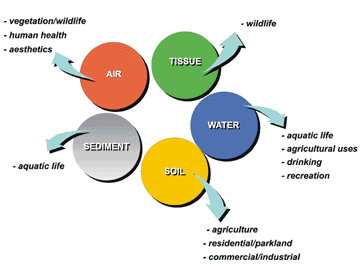

 
|
|
|
|
|
||
|
|

How Clean is Clean?
Since 1987, the Department, working in collaboration with provinces and territories, has developed more than 500 national environmental quality guidelines for over 220 toxic substances of concern in Canada. Already in use in this country across all jurisdictions and recognized as a model for guidelines in Australia, southeast Asia, Mexico, Chile and other parts of the world, they were recently updated and released for the first time as a single compendium by the Canadian Council of Ministers of the Environment (CCME). The publication, entitled 1999 Canadian Environmental Quality Guidelines, is the most comprehensive document of its type ever produced. The development of environmental quality guidelines is carried out at Environment Canada by toxicologists, chemists and biologists who conduct experiments and comprehensive assessments of each substance. Working in cooperation with researchers from other governments, private sector and academia, they evaluate the most up-to-date scientific information available from research around the globe, and use the results to determine the "no effect" levels. To make them truly national, the guidelines proposed are reviewed and approved by the federal, provincial and territorial environment ministries that report to the CCME Ministers. A large and very complex part of this work is establishing scientific protocols for deriving the "no-effect" levels-that is, coming up with objective formulas for determining how much of a substance is too much in the environment. Toxic substances in the environment affect a wide variety of resource uses and, through these uses, numerous different receptors. Receptors affected by soil quality, for example, can include humans, livestock, various food crops and other vegetation, and a host of wildlife species ranging from prairie dogs to earthworms. 
Environmental quality guidelines are also used to promote sustainable agricultural practices. The numerous and varied ecosystems found in Canada have different beneficial uses, so the guidelines are developed to protect, maintain or restore these uses. For example, soil quality guidelines protect and sustain agricultural, residential, commercial and industrial land uses; whereas sediment quality guidelines protect aquatic life, and tissue residue guidelines protect wildlife. Environment Canada's science is critical in the creation of new knowledge and in answering questions regarding the use, behaviour, toxicological effects, major sources, concentrations of chemicals in the environment, their fate and persistence, and the influence of other environmental factors on their toxicity. This information, which is also included in the 1999 Guidelines, provides the scientific context and rationale for the numerical or narrative limits identified, and improves understanding of the impacts of exceeding them. EC scientists are also involved in determining which substances require environmental quality guidelines through their involvement in the development of the National Priority Substances List and other national activities, such as the development of Canada-wide standards. As national benchmarks for the quality of our environment, these guidelines are used in a number of ways. They are used extensively as the scientific basis for environmental regulations and standards, as tools to evaluate the effectiveness of point-source pollution controls for industries, and in the assessment and remediation of contaminated sites. Provincial and territorial governments use them frequently in developing and issuing permits for discharges, and they support a variety of federal legislative acts and international conventions. By indicating changes and trends in concentrations of persistent, bioaccumulative and toxic substances in the ambient environment, the guidelines also enable resource managers to track progress toward virtual elimination of this special group of substances, and can serve as interim management objectives. Used as national recommendations rather than across the board standards, they can also be modified to take into account different resource uses and environmental conditios at the local or regional level. 
Graphic showing how the environmental quality of our land, water and air affects different resources and users. Most importantly, the 1999 Guidelines encourage Canadians to incorporate science into their decision making and to look at environmental conservation and protection in a more holistic manner that takes into consideration the far-ranging impacts of human activities on the environment. The document is already available in both printed format and on CD-ROM, and scientists hope it will eventually become more widely available so that all Canadians can develop science-based solutions to minimizing the impact of their day-to-day lives on the quality of our natural environment. |
|
|
Home | Air | Atmospheric Science | Climate Change | Environmental Action | Habitat | Pollution | Species at Risk | Technology | Water | Weather | Wildlife |
|
|
| Help
| Search
| Canada Site |
|
||
|
The Green LaneTM, Environment Canada's World Wide Web site
|
||
|
|
||
|
|
||